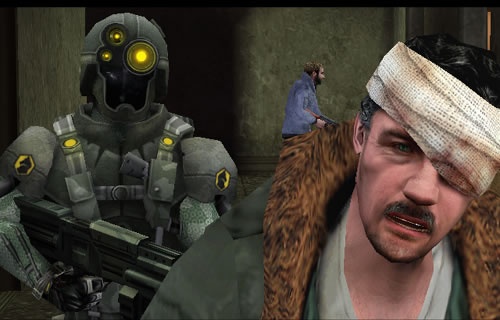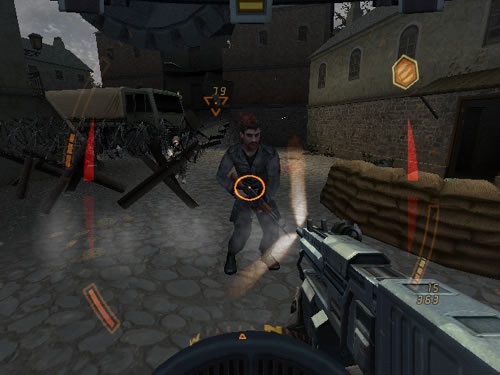Making a new first-person shooter on the Xbox is sort of like opening a new Chinese restaurant in the middle of China Town. Unless you've got some big, creative new hook on the concept, or at least a really high-quality product, odds are you're going to get muscled out by the long-established and typically better competition. Global Star's Classified: The Sentinel Crisis is, unfortunately, a few Szechuan dishes short of a quality restaurant. To its credit, it's better than most budget-priced console shooters tend to be. It's got a decent level of challenge to it, the enemy artificial intelligence uses tactics to its benefit from time to time, and the voice acting isn't so bad. But those positives aside, Sentinel Crisis still can't quite pull together a captivating experience, due in no small part to the complete lack of enjoyable weapons and any sort of multiplayer, as well as a pretty short campaign and bland-looking graphics.

So what, pray tell, is The Sentinel Crisis? Sentinels, in the context of this game, are apparently prototypical American supersoldiers. New Sentinel suits give soldiers extra-special powers, such as multiple vision modes and a Master Chief-esque recharging shield. In fact, the hero of this game--an unnamed army captain, codenamed only as Sentinel 1--sort of looks like a cross between Halo's ultrarecognizable supersoldier and Warsman from the Ultimate M.U.S.C.L.E. cartoons. Anyway, the crisis that takes place to mandate a title like Sentinel Crisis is the kidnapping of a scientist involved with the Sentinel project by an Eastern European general/president named Radulov. Radulov presides over a war-torn nation and is heavy into such things as crushing rebel uprisings, ethnic cleansing, and other unpleasantries generally associated with dictators. You, the captain, are sent in to aid the rebels, get back the scientist, and restore peace to the land.
It's a fairly boilerplate set-up, but it's not nearly as ham-fisted as most of these games tend to be. The story isn't intrusive, the few bits of character dialogue you get aren't bad, and things generally make sense as you go. But really, this isn't a game that's built for a story--it's designed to throw you into hostile situations and have you shoot lots and lots of bad guys. It most certainly does that, but it isn't successful at making it fun. First off, the game can't even manage to make the act of firing a crazy futuristic gun enjoyable. You only have one gun throughout the game, but that gun can pull a presto-changeo and morph from its standard assault-rifle setting into a sniper rifle, shotgun, grenade launcher, and rocket-propelled grenade launcher. That sounds neat, but the shooting itself has no feel to it at all; it's like firing a laser-tag gun. There's just no impact behind the shots, no matter which gun you use. Even the explosive weapons feel bizarrely underwhelming. Oddly enough, the grenades seem to have a bigger impact on nearby enemies than the RPGs. There's also a weird quirk about the gun transformations, in that sometimes switching to a weapon won't yield an instant result. It can take in upward of three seconds for the gun to even start changing forms, which is really obnoxious when you're in the thick of battle and the gun you've got is out of ammo.
One thing Sentinel Crisis does do reasonably well is force you to be a little bit tactical in your thinking. Running and gunning it through levels simply won't fly, as there are too many enemies with wickedly good aim just waiting to pick you off if you try it. Rather, your best course is to pick your spots, take out as many enemies as you can before your shield gets depleted, then find cover while you recharge. Sometimes enemies will pick up on this and come after you while you're behind cover, but other times they'll stand in one spot, firing at the wall you're behind indefinitely. Other times, they won't fire at all, if you manage to stay just far enough outside of their range of detection. Suffice it to say, the artificial intelligence is rather inconsistent, but when it's good, it shows some flashes of realistic troop movements and tactics. And when it's bad, well...
Theoretically adding to the tactical nature of the gameplay is the couple of vision modes you're given. You can use night vision when in dark environments, and there's an enemy-detection mode that gives you a rough location layout for where bad guys are scattered throughout an area. The enemy-detection thing is a neat idea, and it's not just a fat cheat to let you easily kill any bad guy on screen, since they'll often be hidden behind cover, and if they move, the icon depicting where the enemy was doesn't move with them until you shut off the vision mode and turn it on again. The night vision, however, is useless. It's too bright to give you any kind of level of detail upgrade, and it makes things look more washed out than they would in the dark, making it tougher to pick out specific enemies in dark places. Handheld video cameras that you can win off the back of cereal boxes include better night vision capabilities than what this supposedly high-tech government supersoldier suit can offer. How messed up is that?
The biggest thing that sucks the fun right out of Sentinel Crisis is that the missions are just dull. Mostly they're all about getting from point A to point B while killing all the bad guys in between (and occasionally engaging in tasks such as planting bombs, picking up devices, and so on), which by itself isn't a bad thing. But when the act of killing those bad guys isn't inherently fun, that makes this kind of structure really boring. The levels are all linearly laid out, which isn't a bad thing on its own merits, but there's just not much to them. Walk into an area, and it's immediately clear where all the cover points are and where enemies are going to start popping out of. It's all just a foregone conclusion. There's no creativity to any single element of Sentinel Crisis' missions, and because of that, you'll be bored with the experience almost immediately.

There's not much worth looking at in Sentinel Crisis, either. Ancient would probably be the best word to describe this game's visuals. As you run through the overly angular-looking stages, stare at the blurry, blocky enemy models, and watch crappy explosion after crappy explosion, you might be reminded of N64-era shooters such as Goldeneye--and not in a good way. There's just a lot of things about the way this game looks and moves that come off like an unhappy blast from the past. There are some very specific details about the graphics that stand out as not terrible. Your character (on the rare occasions that he appears in cutscenes) usually looks good up close, as does the rebel-leader character (at least his face, anyway). The game uses some occasionally nice lighting effects, and the frame rate holds steady at all times. But with so many glaring issues in level detail, enemy design, and just about everything else, these little details don't manage to salvage the graphics.
Classified: The Sentinel Crisis fails simply because it seems to have little interest in distinguishing itself from any other first-person shooter found on the Xbox. There's very little ambition in anything the game does, and it's this sense of complacence that ultimately sinks it. After all, how much fun can you really have with a shooter where the guns themselves aren't fun to shoot? What's the point of playing a game on the Xbox if it looks like a high-res version of a game from 1998? How much would you want to pay for a drab, six-hour-long single-player campaign and no multiplayer component? Just answer zero to all three and don't bother with The Sentinel Crisis.